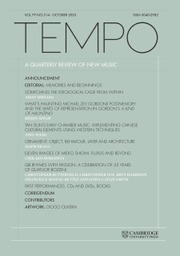No CrossRef data available.
Article contents
ELEVEN IMAGES OF MIEKO SHIOMI: FLUXUS AND BEYOND
Published online by Cambridge University Press: 24 October 2025
Abstract
Mieko Shiomi (b. 1938) is a pioneering Japanese artist, composer, and performer, known for her lifelong practice that crosses the boundaries between music, visual art, and performance, which has evolved fluidly across cultures, media, and technologies. She co-founded a leading postwar Japanese experimental music collective, Group Ongaku, and later joined Fluxus at the invitation of George Maciunas, which led her to spend a year in New York from 1964–65. This article presents 11 images from an extended interview with Shiomi, conducted by composers Chikako Morishita and Akiko Yamane during their visit to her home in Osaka in January 2020, as part of the filming of the documentary Shadow Piece. In the interview, Shiomi reflects on her childhood, education, career, and family life, and discusses the creation and reception of works such as Endless Box, Mirror Piece, and Spatial Poem. The conversation, originally in Japanese, was translated into English by Kiyo Kamisawa and the author.
Information
- Type
- RESEARCH ARTICLE
- Information
- Copyright
- © The Author(s), 2025. Published by Cambridge University Press.
References
1 The air raid on Okayama happened before dawn on 29 June 1945, during the Second World War.
2 The disaster hood was worn by people to protect their heads from fire or falling objects during disasters such as earthquakes.
3 Michiko Sunahara (1923–1987) was a soprano who thrived internationally after the Second World War.
4 A traditional sitting position in Japan: to sit seiza, one must place one’s knees on the floor and sit up on one’s heels.
5 Endless Box is an object-based artwork that visualises diminuendo. It consists of 34 paper boxes arranged in a nested structure: each box is designed to fit into a larger box, and ultimately, all the boxes fit into the largest one. Approximately 25 sets have been created since 1963, and in 2011, a video version was produced under the initiative of the Museum of Contemporary Art, Tokyo. https://post.moma.org/to-the-people-of-the-30th-century-the-lives-of-shiomi-miekos-endless-box/ (accessed 4 March 2025).
6 Minao Shibata (1916–1996) was a Japanese composer who played a leading role in the avant-garde music scene in post-war Japan.
7 Group Ongaku was an avant-garde music ensemble that mainly performed collective improvisations. It was founded around 1960 by students, most of them from the Department of Musicology at Tokyo University of the Arts, and included Takehisa Kosugi, Shuko Mizuno and Shiomi. ‘Ongaku’ means music in Japanese.
8 Galerie J. & J. Donguy was a gallery at 57 rue de la Roquette, Paris; it was founded in 1981 and eventually closed in 2000.
9 Shizuko Watari (1932–2012) was the founder and director of the private Watari-um, Watari Museum of Contemporary Art; http://www.watarium.co.jp/en/about/.
10 For Spatial Poem, Shiomi sent out ‘invitation letters’ to artists worldwide with a series of instructions such as ‘Please do xyz.’ Each recipient arbitrarily interpreted the instructions and carried them out accordingly within the realm of their own daily life, sending back a report to Shiomi as a response. Shiomi edited these reports from various places in the world and mapped the results.
11 See Koji Kawasaki, Japanese Electronic Music: Volume II-Interviews V (Kyoto: Engine Books, 2013), pp. 123–124.
12 An event organised by Takehisa Kosugi, Mieko Shiomi, Yasunao Tone and others in 1969 with the aim of realising and performing pieces by Fluxus and other artists from the 1960s through the concept of intermedia.
13 A series of contemporary music concerts organised by the American Cultural Center since 1967 under the direction of Kuniharu Akiyama, Joji Yuasa and others. Intermedia works, from Japan and abroad, that incorporated technology have been performed.
14 Fluxus Balance was Shiomi’s second collaborative performance work, following Spatial Poem, to use the postal service.


